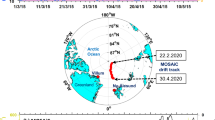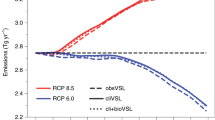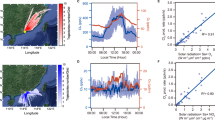Abstract
The cycling of halogen compounds in the lower atmosphere is poorly understood. It is known that halogens such as chlorine, bromine and iodine are converted from halides, which are relatively inert, to reactive radicals. These reactive radicals can affect ozone production and destruction, aerosol formation and the lifetimes of important trace gases such as methane, mercury and naturally occurring sulphur compounds. However, the processes by which halides are converted to reactive halogens are uncertain. Here, we report atmospheric measurements of nitryl chloride, an active halogen, along the southeast coastline of the United States and near Houston, Texas. We show that the main source of nitryl chloride is the night-time reaction of dinitrogen pentoxide with chloride-containing aerosol. The levels observed are much greater than earlier estimates based on numerical models and are sufficiently large to affect oxidant photochemistry in areas where nitrogen oxides and aerosol chloride sources coexist, such as urban areas and ship engine exhaust plumes.
This is a preview of subscription content, access via your institution
Access options
Subscribe to this journal
Receive 12 print issues and online access
$259.00 per year
only $21.58 per issue
Buy this article
- Purchase on Springer Link
- Instant access to full article PDF
Prices may be subject to local taxes which are calculated during checkout



Similar content being viewed by others
References
Platt, U. & Honninger, G. The role of halogen species in the troposphere. Chemosphere 52, 325–338 (2003).
Tanaka, P. L. et al. Direct evidence for chlorine-enhanced urban ozone formation in Houston, Texas. Atmos. Environ. 37, 1393–1400 (2003).
Knipping, E. M. & Dabdub, D. Impact of chlorine emissions from sea-salt aerosol on coastal urban ozone. Environ. Sci. Technol. 37, 275–284 (2003).
von Glasow, R. & Crutzen, P. J. Model study of multiphase DMS oxidation with a focus on halogens. Atmos. Chem. Phys. 4, 589–608 (2004).
Simpson, W. R. et al. Halogens and their role in polar boundary-layer ozone depletion. Atmos. Chem. Phys. 7, 4375–4418 (2007).
Platt, U. & Janssen, C. Observation and role of the free radicals NO3, ClO, BrO and IO in the troposphere. Faraday Discuss. 100, 175–198 (1995).
Pszenny, A. A. P. et al. Evidence of inorganic chlorine gases other than hydrogen-chloride in marine surface air. Geophys. Res. Lett. 20, 699–702 (1993).
Platt, U., Allan, W. & Lowe, D. Hemispheric average Cl atom concentration from 13C/12C ratios in atmospheric methane. Atmos. Chem. Phys. 4, 2393–2399 (2004).
Spicer, C. W. et al. Unexpectedly high concentrations of molecular chlorine in coastal air. Nature 394, 353–356 (1998).
Law, K. S. & Stohl, A. Arctic air pollution: Origins and impacts. Science 315, 1537–1540 (2007).
Finlayson-Pitts, B. J., Ezell, M. J. & Pitts, J. N. Formation of chemically active chlorine compounds by reactions of atmospheric NaCl particles with gaseous N2O5 and ClONO2 . Nature 337, 241–244 (1989).
Behnke, W., George, C., Scheer, V. & Zetzsch, C. Production and decay of ClNO2, from the reaction of gaseous N2O5 with NaCl solution: Bulk and aerosol experiments. J. Geophys. Res. 102, 3795–3804 (1997).
Finlayson-Pitts, B. J. The tropospheric chemistry of sea salt: A molecular-level view of the chemistry of NaCl and NaBr. Chem. Rev. 103, 4801–4822 (2003).
Behnke, W., Kruger, H. U., Scheer, V. & Zetzsch, C. Formation of atomic Cl from sea spray via photolysis of nitryl chloride—determination of the sticking coefficient of N2O5 on NaCl aerosol. J. Aerosol Sci. 22, S609–S612 (1991).
Frenzel, A. et al. Heterogeneous interconversion reactions of BrNO2, ClNO2, Br2, and Cl2 . J. Phys. Chem. A 102, 1329–1337 (1998).
Erickson, D. J. III, Seuzaret, C., Keene, W. C. & Gong, S. L. A general circulation model based calculation of HCl and ClNO2 production from sea salt dechlorination: Reactive chlorine emission inventory. J. Geophys. Res. 104, 8347–8372 (1999).
McFiggans, G., Cox, R. A., Mossinger, J. C., Allan, B. J. & Plane, J. M. C. Active chlorine release from marine aerosols: Roles for reactive iodine and nitrogen species. J. Geophys. Res. 107, 4271 (2002).
Pechtl, S. & von Glasow, R. Reactive chlorine in the marine boundary layer in the outflow of polluted continental air: A model study. Geophys. Res. Lett. 34, L11813 (2007).
Osthoff, H. D. et al. Observation of daytime N2O5 in the marine boundary layer during New England Air Quality Study—Intercontinental Transport and Chemical Transformation 2004. J. Geophys. Res. 111, D23S14 (2006).
Fuchs, N. A. & Sutugin, A. G. Highly Dispersed Aerosols (Ann Arbor Science Publishers, Newton, 1970).
Rossi, M. J. Heterogeneous reactions on salts. Chem. Rev. 103, 4823–4882 (2003).
Clegg, S. L., Brimblecombe, P. W. & Wexler, A. S. A thermodynamic model of the system H–NH4–Na–SO4–NO3–Cl–H2O at 298.15 K. J. Phys. Chem. A 102, 2155–2171 (1998).
Wilkins, R. A. Jr, Dodge, M. C. & Hisatsune, I. C. Kinetics of nitric oxide catalyzed decomposition of nitryl chloride and its related nitrogen isotope exchange reactions. J. Phys. Chem. 78, 2073–2076 (1974).
Brown, S. S. et al. Nighttime removal of NOx in the summer marine boundary layer. Geophys. Res. Lett. 31, L07108 (2004).
Platt, U. et al. Free radicals and fast photochemistry during BERLIOZ. J. Atmos. Chem. 42, 359–394 (2002).
Stutz, J. et al. Relative humidity dependence of HONO chemistry in urban areas. J. Geophys. Res. 109, D03307 (2004).
Alicke, B. et al. OH formation by HONO photolysis during the BERLIOZ experiment. J. Geophys. Res. 108, 8247 (2003).
Roberts, J. M. et al. Measurements of PANs during the New England Air Quality Study, 2002. J. Geophys. Res. 112, D20306 (2007).
Wang, L., Thompson, T., McDonald-Butler, E. C. & Allen, D. T. Photochemical modeling of emissions trading of highly reactive volatile organic compounds in Houston, Texas. 2. Incorporation of chlorine emissions. Environ. Sci. Technol. 41, 2095–2102 (2007).
Hinrichsen, D. Coastal Waters of the World: Trends, Threats, and Strategies (Island Press, Washington, 1998).
Olivier, J. G. J. & Berdowski, J. J. M. in The Climate System (eds Berdowski, J., Guicherit, R. & Heij, B. J.) 33–78 (A. A. Balkema Publishers/Swets & Zeitlinger Publishers, Lisse, The Netherlands, 2001).
Dentener, F. J. & Crutzen, P. J. Reaction of N2O5 on tropospheric aerosols: Impact on the global distributions of NOx, O3 and OH. J. Geophys. Res. 98, 7149–7163 (1993).
Slusher, D. L., Huey, L. G., Tanner, D. J., Flocke, F. M. & Roberts, J. M. A thermal dissociation-chemical ionization mass spectrometry (TD-CIMS) technique for the simultaneous measurement of peroxyacyl nitrates and dinitrogen pentoxide. J. Geophys. Res. 109, D19315 (2004).
McNeill, V. F., Patterson, J., Wolfe, G. M. & Thornton, J. A. The effect of varying levels of surfactant on the reactive uptake of N2O5 to aqueous aerosol. Atmos. Chem. Phys. 6, 1635–1644 (2006).
Dubé, W. P. et al. Aircraft instrument for simultaneous, in situ measurement of NO3 and N2O5 via pulsed cavity ring-down spectroscopy. Rev. Sci. Instrum. 77, 034101 (2006).
Osthoff, H. D. et al. Measurement of atmospheric NO2 by pulsed cavity ring-down spectroscopy. J. Geophys. Res. 111, D12305 (2006).
Quinn, P. K. et al. Impacts of sources and aging on submicrometer aerosol properties in the marine boundary layer across the Gulf of Maine. J. Geophys. Res. 111, D23S36 (2006).
Williams, E. J. et al. Intercomparison of ground-based NOy measurement techniques. J. Geophys. Res. 103, 22261–22280 (1998).
Stark, H. et al. Atmospheric in situ measurement of nitrate radical (NO3) and other photolysis rates using spectroradiometry and filter radiometry. J. Geophys. Res. 112doi:10.1029/2006JD007578 (2007).
Scheuer, E. et al. Seasonal distributions of fine aerosol sulfate in the North American Arctic basin during TOPSE. J. Geophys. Res. 108, 8370 (2003).
Dibb, J. E. et al. Ship-based nitric acid measurements in the gulf of Maine during New England Air Quality Study 2002. J. Geophys. Res. 109, D20303 (2004).
Acknowledgements
We thank the officers and crew of the NOAA R/V R. H. Brown for their assistance and professionalism. We thank S. Herndon and M. Zahniser for the use of their formaldehyde data. We thank J. Thornton for helpful discussions. We thank D. Tanner, G. Huey, A. Neuman, J. Nowak, W. P. Dubé and S. Ciciora for help with instrumentation. The EDGAR 3.2 NOx emissions data were obtained from the website http://www.mnp.nl/edgar/. This work was supported by the NOAA Climate Forcing and Air Quality Programs.
Author information
Authors and Affiliations
Corresponding authors
Supplementary information
Supplementary Information
Supplementary figures S1-S2 and tables S1-S2 (PDF 323 kb)
Rights and permissions
About this article
Cite this article
Osthoff, H., Roberts, J., Ravishankara, A. et al. High levels of nitryl chloride in the polluted subtropical marine boundary layer. Nature Geosci 1, 324–328 (2008). https://doi.org/10.1038/ngeo177
Received:
Accepted:
Published:
Issue Date:
DOI: https://doi.org/10.1038/ngeo177
This article is cited by
-
Increased night-time oxidation over China despite widespread decrease across the globe
Nature Geoscience (2023)
-
Widespread detection of chlorine oxyacids in the Arctic atmosphere
Nature Communications (2023)
-
Enhanced aerosol particle growth sustained by high continental chlorine emission in India
Nature Geoscience (2021)
-
Computational study on the mechanism and kinetics of Cl-initiated oxidation of ethyl acrylate
Structural Chemistry (2017)
-
Evidence for strong, widespread chlorine radical chemistry associated with pollution outflow from continental Asia
Scientific Reports (2016)



